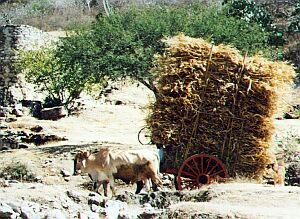Home >>
Oaxaca >>
Oaxaca, Oaxaca >>
An Expatriate Life >>
Letters >>
Timing is Everything
Question: when does the last bus for (fill in the name of your favorite Oaxaca destination here) come by? Answer: after the next-to-the-last one.
This exchange tells you everything you have to know about bus service in Oaxaca. It also tells you about when to cross the street, how to shop for a serape, and why everyone is so agreeable.

This picture was taken from the ruins at Lambetyeco, near Oaxaca city. It's meant to convey the mix of modern and ancient that one runs into all the time in southern Mexico. Notice the bicycle wheel uphill from the hay load. A more modern commuter is just about to pass.[Photo by Diana Ricci]
|
Buses in Oaxaca leave from the center of town and travel outward. When they get where they are going, they sit while the driver chats with the inspector at the end of the line, and then they resume their roundelay. Sometimes the driver stops along the way for a quart of oil, a "Coca" or to kick a tire. Occasionally, two drivers pull up alongside each other and chat for a moment, either verbally or by hand signals. There is no such thing as a "schedule". Schedules are far too restrictive, too un-natural. Why would you need a schedule? You go when you can, stop when you must, and collect the fare from everyone who can pay it.
That's not to say that there are no rules. They just aren't written down; one has to divine them through observation, well-formed questions and endless miles of bouncing, jouncing, buoyant busriding.
Rule number one: bus-stops are in fixed positions, but people are not; no matter where they are, when they wave, you stop. Middle of the block, middle of a controlled intersection, twenty yards past the last passenger pickup: no matter, a fare is a fare.
Rule number two: it's up to you. If the bus is filling up, or if you don't feel like stopping, or if you don't like their looks, or if they are just gringo tourists who should probably be taking a cab anyway, you can ignore rule number one. This rule applies even to people waiting in bus stops.
Rule number three: first come, first filled. Every time you pass another bus, you will get his passengers. Since almost all inbound buses go to the same destination near the central market, and since almost all outbound buses follow the same few routes until they get well out of the center, the leapfrogging gets pretty wild. You haven't lived until you have experienced a three-lane drag race of snorting gear-clashing 54-passenger Dina diesel transports.
Rule number four: play your radio loud. It helps to drown out the roar of the unmuffled diesel engine, and the screeching noise when you put on the brakes.
Rule number five: decoration is everything. The rattier the bus, the more likely that the driver will have festooned it with colored (and sometimes blinking) lights, decals of the bleeding heart of Jesus, dayglo inscriptions of his sweetheart's name, and strings of tinsel. Some buses have complete biblical events on the dashboard (creches and last suppers are the favorites, although I recall one particularly bloody scene of Salome holding the head of John the Baptist).
Rule number six: never sacrifice performance for the sake of the environment. Anyone who wants a little taste of the gas chambers at Auschwitz is invited to stand on the curb near the back of a diesel behemoth as it grinds into first gear and accelerates away. Pure urban, man.
Rule number seven: make the other guy do the crawling. Folks here claim the aisle seat first. They do not like to crawl over each other to get in or out of the window seat. Often, the aisles will be full of standees, even though there are empty window seats. It seems to me that a sociologist could get several learned papers from this behavior. My own theory is that it has to do with some deeply ingrained aversion to sticking one's behind in someone else's face...
Rule number eight: there are no rules; at least no fixed ones. Life is too important to clutter it up with rules. There are only situations, and each will be unique, with it's own imperatives. Stay loose.
Which brings us to the introduction. When do you cross the street? When you can, whether the light is green, red or nonexistent. How do you buy a serape? In whatever manner pleases you; that's how the other guy is selling it. Why is everyone so agreeable? Because "yes" means "maybe" (nobody who is simpatico likes to say "no"; it's easier to say yes and just fade).
Get it? It's all situational: an unfolding process in which nothing is assured, and one exists in a constant state of wonder. As in, "I wonder when the next bus will arrive?".
(May, 1997)
| Top of page |
